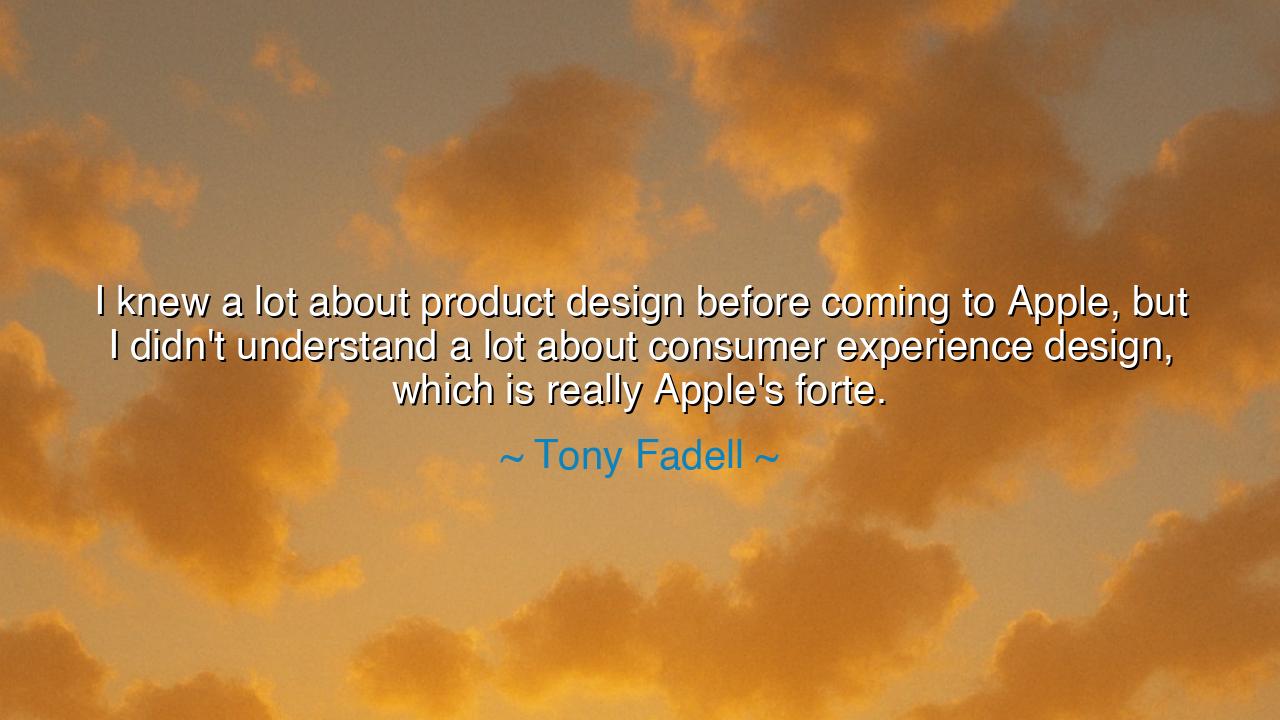
I knew a lot about product design before coming to Apple, but I
I knew a lot about product design before coming to Apple, but I didn't understand a lot about consumer experience design, which is really Apple's forte.






“I knew a lot about product design before coming to Apple, but I didn’t understand a lot about consumer experience design, which is really Apple’s forte.” — Tony Fadell
In this humble and revealing reflection, Tony Fadell, one of the great innovators of our age, speaks not only of technology but of wisdom itself. When he says he “knew a lot about product design,” yet did not understand “consumer experience design,” he confesses something profound — that knowledge of things is not the same as knowledge of people. A product may be beautiful, efficient, and strong, yet if it does not touch the human spirit, it remains lifeless. Through his time at Apple, under the vision of Steve Jobs, Fadell came to understand that the truest design is not the creation of an object, but the shaping of an experience — the invisible bridge between human desire and human joy.
To grasp the weight of his words, we must first understand who Tony Fadell was. Before joining Apple, he was already an accomplished engineer and designer, skilled in the making of devices and systems. But when he entered the culture of Apple, he stepped into a temple where technology was treated as an extension of the soul. There, design was not merely about how something looked or functioned, but how it felt — how it spoke to the senses, how it simplified life, how it gave beauty to the everyday. Fadell’s confession marks his awakening to this truth: that human-centered design is the highest form of creation, for it serves not the machine, but the heart that uses it.
This lesson is as old as civilization itself. The ancient Greeks, who built temples and amphitheaters that still stand today, understood that form and function alone were not enough. The Parthenon was not merely a structure of stone; it was an experience — designed to inspire awe, to elevate the mind toward the divine. In the same way, Apple’s devices were built to elevate daily life — to make technology not a burden, but a companion. Just as the architects of old designed for the human soul, not only the human hand, so too did Apple design for the experience of living, not merely for the operation of tools.
What Fadell discovered was that great design begins not in the laboratory, but in empathy. To create something meaningful, one must see the world through another’s eyes — feel their frustrations, their delights, their hopes. A mere product solves a problem; an experience transforms it into joy. This is why a person does not love their device because it is powerful, but because it feels personal — because it seems to understand them. Apple’s genius was to blend art and engineering into something seamless, something that disappears in use, leaving only the sensation of delight.
Consider the creation of the iPod, the device that would forever change the music industry. Before Apple’s version, MP3 players already existed. They played songs, stored files, and looked sleek enough — but they lacked soul. Fadell and his team, guided by Jobs’ relentless insistence on simplicity and emotional impact, did not just build a product; they built a feeling. The scroll wheel, the clarity of the screen, the rhythm of navigation — all became part of an experience so intuitive that it felt inevitable. With the iPod, music was no longer a task to manage but a pleasure to live. This was consumer experience design — the alchemy that turns function into meaning.
In his humility, Fadell reminds us that even the most skilled must remain students of the human experience. Knowledge of tools is important, but wisdom lies in understanding people — how they think, how they feel, how they connect. This is the difference between invention and creation: the inventor builds for himself, the creator builds for others. And when creation serves others with grace and empathy, it ceases to be a mere craft — it becomes art.
Lesson:
From Tony Fadell’s words, we learn that mastery begins not with control, but with curiosity. To build anything of worth — a product, a home, a work of art, a life — one must ask, How will this make another feel? The experience of others must become the measure of our success. Therefore, in your own work, do not stop at function; reach for meaning. Do not design for the hand, but for the heart. For the greatest creations, whether in technology or in life, are not those that merely work — they are those that make people feel seen, understood, and uplifted. In this, the wisdom of the ancients and the genius of the modern world are one and the same.






AAdministratorAdministrator
Welcome, honored guests. Please leave a comment, we will respond soon